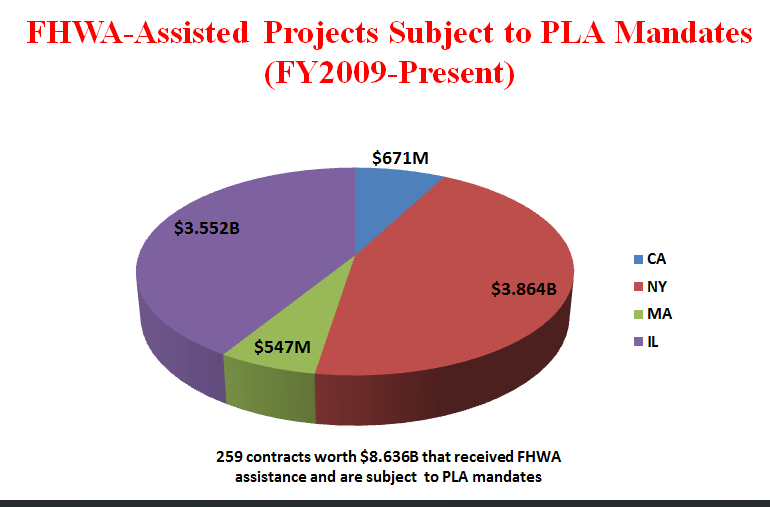Illinois Gov. Rauner Calls for Project Labor Agreement and Prevailing Wage Reform
Yesterday, Republican Gov. Bruce Rauner delivered a State of the State address to Illinois lawmakers, laying out bold reforms to make Illinois more competitive.
Included in Gov. Rauner’s plan to reinvent Illinois is a call to eliminate anti-competitive and costly government-mandated project labor agreements (PLAs) and reform Illinois prevailing wage rules, which will help reduce taxpayer-funded construction costs and create more opportunities for the merit shop contracting community.
The Chicago Tribune editorial board called his plan refreshing.
Last week, the WSJ gave readers a preview of this plan while covering Gov. Rauner’s remarks around the state (“Bruce Rauner Almighty,” 1/30/15).
From the WSJ:
For starters, he wants to do away with project labor agreements (PLAs) “that are basically what the unions have worked out with the politicians” who “they influence with campaign cash and then impose those contracts on the businesses that contract with the state.” Mr. Rauner complained that PLAs, which usually require contractors to pay union wages and benefits on public construction projects, increase costs by about 18%.
The Illinois News Network reports the Rauner administration is investigating a solution to reduce costs to repair the governor’s executive mansion by an estimated 22 percent via eliminating prevailing wage requirements (“Governor’s Mansion repair bid opens discussion on prevailing wage,” 2/2/15):
Newman presented the state with two estimates on what it would cost to repair the governor’s mansion.
One estimate was based on his employees being paid their usual rate and the second is based on them receiving the “prevailing wage.”
If Newman’s company, Newman-Alton Inc., were to pay the prevailing wage, the cost to the taxpayers to repair the mansion would be $1.91 million. If there were no prevailing wage law his firm would charge $1.56 million,” he said.
He noted that the prevailing wage law increased the estimated cost of the project by 22 percent or $350,000.
“Through many, many years of organized labor and political situations its gotten really out of hand,” Newman said. “The taxpayers are feeling the brunt of it.”
“I’ll tell you where it really hurts is in these small towns and school districts,” Newman said. “It increases the cost of building schools and means fewer schools ultimately get built.”
Here is Gov. Rauner’s remarks on PLAs and prevailing wage during his State of the State address:
“Empowerment means giving governments the ability to lower costs by reforming project labor agreements and prevailing wage requirements that block true competitive bidding. These requirements can increase the costs of taxpayer funded construction projects by 20 percent or more. At the Illinois Tollway, uncompetitive bidding has cost toll payers over $1 billion since 2005. At the Dept. of Transportation, uncompetitive bidding costs taxpayers more than $100 million per year. Reforming the prevailing wage laws could save our schools nearly $160 million every year. We must restructure the bidding for construction projects at every level of government because reforms will save taxpayers billions. And we can reinvest those billions in even more capital projects to help our schools and our communities.”
The data supporting this statement appears to be from page 27 of a PowerPoint presented Jan. 27 at the Richland Community College in Decatur (Gov. Bruce Rauner on labor, economy: The Illinois Turnaround).
Illinois has a sordid history of requiring PLAs.
In 2011, state legislators sent The Project Labor Agreements Act (H.B. 2987), to Gov. Pat Quinn (D) who signed it into law on July 27. This bill enacts the language of Quinn E.O. 3 of 2010 and former Gov. Rod Blagojevich’s E.O. 13 of 2003 into statute. These orders, and H.B. 2987, encourage state agencies to require wasteful and discriminatory PLAs on taxpayer-funded construction on a case-by-case basis.
The Illinois Capital Development Board (CDB) reports there are 830 active and completed projects subject to government-mandated PLAs valued at $4.401 billion (from page 36 of the latest CDB report):
In addition, a May 2013 report by the U.S. Department of Transportation (DOT) revealed the Illinois Department of Transportation was granted permission from the U.S. DOT to require PLAs on 246 projects valued at $3.522 billion since President Obama’s Feb. 6, 2009, pro-PLA Executive Order 13502 was put into federal procurement regulations. The discriminatory Obama order encourages federal agencies to mandate PLAs on federal construction projects exceeding $25 million in total value on a project-by-project basis. The order also permits (but does not require) private, local and state recipients of federal assistance to mandate PLAs—a practice prohibited from 2001 to 2009 by President George W. Bush’s Executive Orders 13202 and 13208.

From 2009-May 2013, Illinois led the country in the number of federally assisted FHWA projects subject to a government-mandated PLA and is second in total value.
Sadly, this is just a snapshot of Illinois’ love-affair with PLAs, which even resulted in Chicago-style politics strong-arming Wal-Mart into requiring PLAs on new stores in the greater Chicagoland region as a condition of construction approval in 2011.
It will be interesting to see how Gov. Rauner maneuvers legislative reforms through Springfield, where union-favoring Democrats control the Illinois Senate 39-20 and the House 71-47. However, some executive actions can be taken to restore fairness and competition in Illinois public works contracting. Despite the challenges, the country is watching and rooting for the new GOP governor to pull off a miracle in a troubled and deep blue state.














One Response to Illinois Gov. Rauner Calls for Project Labor Agreement and Prevailing Wage Reform
Please lets just look at the Mathematical Facts about increased costs. no emotion no bias just math
I would ask that you consider your facts prior to publishing things that are just simply not mathematically possible. Stating that a construction projects comes in at a 18% lower cost is simply is not possible by lowering labor rates below the prevailing wage.
Consider this:
1. Total labor costs for the average government construction project are twenty-five percent of the construction value.
2. If salaries on Prevailing Wage Projects were twenty-five percent higher than non-prevailing wage projects (5-20% is more typical), then
3. The maximum increase to the entire project can only be (25%*25%) or 5.25% .
4. If wages were 50% higher, then the Project would be 11.5% more expensive.
However, this all assumes the same number of hours are worked by both workforces; this is not likely, as many studies show that prevailing wage workers are generally higher skilled and more efficient, resulting in fewer hours worked. So you may be paying more per hour, but paying for fewer hours worked. Studies referenced below have shown prevailing wage projects are up to 20% more efficient on hours charged, and this equalizes the overall cost of prevailing wage projects.
1. *The Fiscal Policy Institute, The Economic Development Benefits of Prevailing Wage, May, 2006.
2. *Building the Golden State: The Economic Impacts of California’s Prevailing Wage Policy
Other impacts of paying prevailing wages are:
1. Prevailing wage workers pay more taxes.
2. Prevailing wage workers are less likely to be on public assistance.
3. Prevailing wage workers have lower accident rates.
4. Quality of finished construction is generally higher, leading to lower operating and maintenance costs.